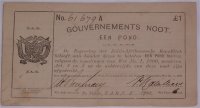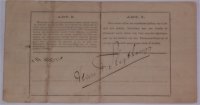 |
 |
 |
One Pound in VF/EF |
Five Pound in EF (Earlier note) |
Fifty Pound in VF/EF |
The ZAR Bank notes 1900 - 1902
Government notes (“Gouvernements noten”) The political and military developments of the Anglo-Boer War and the subsequent economic depression in the Republic are well known.
In the disruptive conditions caused by the turn of the tide of war, it is not surprising that the government of the Republic legally sought refuge in paper money to pay its officials and to pay for military supplies. Provision was made for the printing of 1,000,000 government notes with values of £1, £5, £10, £20, £50 and £100. The notes would be redeemable on 1 June 1901.
The first banknotes issued by the ZAR Government during the Boer War were emergency notes issued in Pretoria were dated 28.5.1900 essentially for the payment of Boer Government officials and military supplies. They were issued At PRETORIA under ZAR Law No.1 which the British repudiated immediately (proclamation No.8) saying they would not be recognised except as evidence of war losses. The British later relented and honoured notes passed by the Central Judicial Commission.
They did not circulate long in Pretoria. Ten days later on 6th June 1900 the British marched in under Lord Roberts and occupied the Capital of the Boer Republic. The soldiers marched into the main square with their bayonets fixed - the Boers elected not to engage in a pitched battle and retired to Machadodorp and then to Pietersburg (where a second issue of notes was made). On 1 July 1900, Roberts announced that the British authorities declined to recognise the validity of these notes and declared them illegal. While these notes (and the later issues) were secured by all the fixed assets of the state at 6 per cent interest a year, most never redeemed, because the Republic lost the war. The notes were embossed with the great seal of the Zuid- Afrikaansche Republiek (ZAR). The notes were numbered and signed personally by the Treasurer-General, N.S. Malherbe, and the Auditor-General, J.S. Marais. The difference in the decorative motif is striking. The abbreviation “No.” (for number) was omitted on the earlier notes. The notes were printed on white paper of good quality with a green tinge printing and were known as “green backs” as the general impression of their colour was green. The later series had a blackish over-all colour. These notes became known among the public as “blue backs”, possibly owing to the historical association with the previous green backs.
The wording on the notes reads: "The Government of the South African republic promises to pay the bearer of this note xxx pound sterling, according to law No.1, 1900, of which articles 2 and 3 are printed on the reverse of this note. This note is guaranteed by all fixed properties of the State as defined in Law No.1"
The reverse shows that there was an element of gamble about redemption - but also a six per cent interest per annum. It reads: "Article 2. These notes will have a fixed rate until they are redeemed; their redemption will be conducted by means of a draw, the details of which will be made known later, and will commence on 1st June 1901, when a sum of £100,000 sterling will be redeemed, which will be repeated on the 1st June each year with an amount of £100,000 sterling until the total amount is redeemed. As soon as a note is taken out of circulation and repaid, it will be destroyed by the Treasurer General and Auditor General in the presence of two people appointed by the Government. Article 3. These notes will bear an interest rate of six per cent per annum, payable to the holder in cash every first of June, for the previous year, at the office of the Treasurer General or at a bank appointed by proclamation."
The numbers of notes issues was quite small, for example, the highest number recorded on the £100 notes is 765 which indicates a probable total printing of only 800.
 |
 |
 |
One Pound in VF/EF |
Five Pound in EF (Earlier note) |
Fifty Pound in VF/EF |
After the British took Pretoria, the only free printing works was that of Zoutpansberg Wachter in Pietersburg. This was then declared the State Printing Works and adapted for the purpose of printing emergency bank notes. The staff comprised three persons, one of whom, J.P. Vorster, a typesetter, performed a great service to the Zuid-Afrikaansche Republiek. In Pretoria, where he had completed his apprenticeship, he had acquired the proud reputation of being the fastest compositor – he could “comp” at sixty-five letters a minute (in those days, compositors or hand-setters packed the letters from various “cases” and “fonts” of letter types into a composing stick). Vorster proceeded to print the paper money his country needed so desperately – 116,000 notes to the value of £220,000 in denominations of £1, £5, £10, £20, £50 and £100. These were later nick-named the “blue backs”. Despatch riders carried the money to the Government at Machadadorp. The early notes were embossed with a watermark from a typewriter but after a while the boers gave up with this and left the notes blank before printing.
The paper on which these notes had been printed varied in thickness and the quality was generally much poorer than that of the Pretoria issue. Technical production was also inferior: the notes were not embossed, since the press had been too heavy to transport. The notes were signed by the Auditor-General, A.P. Brugman and the Treasurer-General, P.R. de Villiers. There were three separate issues dated 1 February, 1 March and 1 April 1901. When the British entered the Pietersburg district in March 1901, Vorster had to flee and leave his printing press behind. It was later blown up by the British.
The Balson Holdings Family Trust holds the Pietersburg notes seen below, the notes in the first row with the typewriter watermark
(The Treasury on wheels: notes in the field.) It was a heavy blow for the Boers when the British forces under Brigadier-General H.C.O. Plummer took Pietersburg on 8 April 1901. Vorster’s press was destroyed, and they lost their entire supply of bank notes to the British at Lydenburg. For a state requiring money to conduct a war, some of the 530 gold veld ponde (field pounds) of P.J. Kloppers were meagre indeed and the Boer forces were heading for a financial crisis. Money had to be found somewhere. A printing press was urgently needed. Again Kloppers’ ingenuity came to the rescue. A small hand press was discovered in Pilgrim’s Rest. It was broken and incomplete, but after being repaired by Gyzelman, formerly of the Government Printing Works in Pretoria, and one Hendricks, it was used to print some paper money. Some of the letters, as well as the ink, had to be made by the printers themselves. Kloppers etched the Republican Coat of Arms in copper and pressed it into lead to make a printing block. And so the last of the “blue backs” (this time in the field) were issued. The notes were dated 1 March, 1 April and 1 May 1902, and were in £1, £5 and £10 values. In circumstances such as these, some printer’s errors crept in.
See Klopper's role in the minting of the gold Veld Pond
Very limited research has actually been done on the actual notes issued and from my own experience note dealers had different explanations, ideas and opinions. Hopefully, my research will not only help me, but other collectors in the future. As and when I am able to complete my research I will publish a paper and share with all interest parties my findings. The Africans in the Pilgrims Rest district stopped accepting the bank notes in exchange for crops or labour - resulting in the boers minting the Veld Pond, South Africa's most sought after numismatic item.
 |
 |
Redemption of the ZAR notes
At the surrender negotiations at Vereeniging on May 15 1902 Lord Kitchener and his team met with General J.C.Smuts (later to fight with great success for the British) and Generals C.R. de Wet, Louis Botha, and others. There it was agreed to redeem notes accepted as genuinely issued by the Central Judicial Commission, whose stamp would be applied to the notes if they met the terms of the ZAR Law No.1 and the holder had given due value for them. But no interest would be paid.